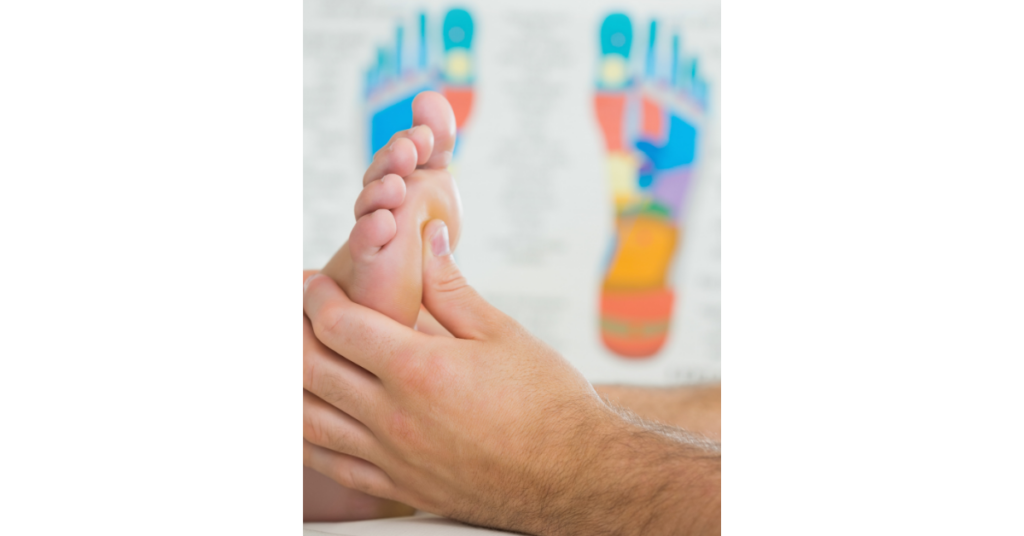Reflexology
Reflexology is a specific pressure technique applied to the hands and feet, though usually, one or both feet are worked on.
The principle behind reflexology is that the foot is a ‘map’, in miniature, of the body. Although no one knows how it works, reflexology has a long history of use. Reflexology has its root in ancient civilisations, as records suggest that variations upon modern day reflexology were used in Ancient Egypt, China, Africa, and Indigenous Americans.
Our bodies consist of organs and systems. There are nine systems in all: Cardio-vascular, respiratory, the skeletal, the muscular, the nervous system, the digestive, the urinary, the reproductive, and the endocrine (this is the hormonal or chemical system) of the body. Practitioners believe that reflexology assists the body in keeping all these systems working in balance with each other. Anecdotal evidence seems to suggest that it is an excellent treatment for many conditions including pre-menstrual syndrome (PMS), digestive disorders, sinusitis, and aches and pains.
What To Expect When You Visit A Therapist
On your first visit, you will be asked to verbally go through your medical history and lifestyle with the therapist. This is so that they can have an understanding of all the factors that may be affecting your health and help them to assess how you are emotionally and physically.
Reflexology is performed on bare feet with the patient in a semi or full upright position. The treatment is given by one practitioner, who will perform ‘inching’ movements along the foot with his or her hands. (If you imagine the movement a caterpillar makes, well that is how the practitioners thumb or finger will be moving across your foot.)
First visits take about 40 minutes for the consultation and 45 minutes for the treatment. Subsequent visits usually last for an hour. As to how often you will need a treatment will depend on how your therapist assesses you, but treatments are usually once a week, although fortnightly or monthly treatments may be advised. Many benefit from one treatment only.
The one thing to remember is you don’t have to have anything wrong with you to take advantage of such a wonderful therapy. Reflexology reduces feelings of stress; it calms and soothes, relaxes the mind and body and encourages elimination. In addition, it improves circulation and feels wonderful. In general, reflexology does not hurt, and if you do feel a little discomfort at any point in the treatment, the therapist will tailor the treatment to suit your needs. Reflexologists believe that areas of tenderness in the feet may correspond to areas of the body that need attention.
How much does a session cost?
You can expect to pay around £40 to £90 for an initial session – this depends upon the practitioner, experience, location, and a variety of factors. Subsequent sessions will sometimes cost less.
Is there any evidence of efficacy?
Although reflexology has a very long history of use with great anecdotal success, there are currently not very many scientific trials that support its efficacy. Because of this conflict, it is obvious that more trials need to be done, however this site has a list of research studies in reflexology and it makes interesting reading!
Courses and Practitioners
Check this site for both courses and practitioners using the links above – The Complementary Medical Association provides a free to access list of excellent training courses that are registered with us – and a register of highly qualified practitioners.
History (In Brief)
The history of Reflexology has its roots in many cultures and races of people. The Egyptians can trace their history of foot Reflexology to 2,500 BC as evidenced by papyrus drawings.
In India pressure techniques are performed on the feet as part of Ayurvedic medicine, these are skills that have been passed down through generations by word of mouth. Indigenous Americans have a tradition whereby they treat the whole body though the feet, and this practice has been passed down through various tribes.
In ancient China, acupuncture treated many points on the feet for healing. Russia and Germany have contributed hugely to our modern day understanding and usage of reflexology.
In the US two medical doctors, William Fitzgerald and Edwin Bowers, are generally acknowledged to be the forefathers of modern reflexology. Fitzgerald went on trips and studied the Cherokee tribes and their foot massages. He was head of the Ear, Nose, and Throat hospital in Connecticut, and as early as 1971, he discovered that pressure on the hands and feet produced pain relief in the body. Bowers mapped out the ten ‘zone lines used by reflexologists – three lines are believed to correspond to various linked areas on the human body. This is similar to the meridians that are said to exist in Traditional Chinese Medicine. He was ridiculed by members of his profession, but he went on regardless and taught Dr Riley, who passed on the information to his wife Elizabeth, who in turn passed it on to a massage therapist called Eunice Ingham.
At the age of 80, after taking herself across America in 1938 and writing two books, Ingham was faced with trouble and threatened with legal action for practising medicine without a licence. The charges were dropped possibly due to her age. She taught reflexology up to her death in 1974.

